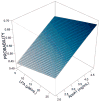Lysophosphatidic acid and apolipoprotein A1 predict increased risk of developing World Trade Center-lung injury: a nested case-control study
- PMID: 24548082
- PMCID: PMC4306444
- DOI: 10.3109/1354750X.2014.891047
Lysophosphatidic acid and apolipoprotein A1 predict increased risk of developing World Trade Center-lung injury: a nested case-control study
Abstract
Rationale: Metabolic syndrome, inflammatory and vascular injury markers measured in serum after World Trade Center (WTC) exposures predict abnormal FEV1. We hypothesized that elevated LPA levels predict FEV₁ < LLN.
Methods: Nested case-control study of WTC-exposed firefighters. Cases had FEV₁ < LLN. Controls derived from the baseline cohort. Demographics, pulmonary function, serum lipids, LPA and ApoA1 were measured.
Results: LPA and ApoA1 levels were higher in cases than controls and predictive of case status. LPA increased the odds by 13% while ApoA1 increased the odds by 29% of an FEV₁ < LLN in a multivariable model.
Conclusions: Elevated LPA and ApoA1 are predictive of a significantly increased risk of developing an FEV₁ < LLN.
Conflict of interest statement
Figures


Similar articles
-
Biomarkers of World Trade Center Particulate Matter Exposure: Physiology of Distal Airway and Blood Biomarkers that Predict FEV₁ Decline.Semin Respir Crit Care Med. 2015 Jun;36(3):323-33. doi: 10.1055/s-0035-1547349. Epub 2015 May 29. Semin Respir Crit Care Med. 2015. PMID: 26024341 Free PMC article. Review.
-
Assessing the Protective Metabolome Using Machine Learning in World Trade Center Particulate Exposed Firefighters at Risk for Lung Injury.Sci Rep. 2019 Sep 3;9(1):11939. doi: 10.1038/s41598-019-48458-w. Sci Rep. 2019. PMID: 31481674 Free PMC article.
-
Receptor for advanced glycation end-products and World Trade Center particulate induced lung function loss: A case-cohort study and murine model of acute particulate exposure.PLoS One. 2017 Sep 19;12(9):e0184331. doi: 10.1371/journal.pone.0184331. eCollection 2017. PLoS One. 2017. PMID: 28926576 Free PMC article.
-
Cardiovascular biomarkers predict susceptibility to lung injury in World Trade Center dust-exposed firefighters.Eur Respir J. 2013 May;41(5):1023-30. doi: 10.1183/09031936.00077012. Epub 2012 Aug 16. Eur Respir J. 2013. PMID: 22903969 Free PMC article.
-
Potential for diffuse parenchymal lung disease after exposures at World Trade Center Disaster site.Mt Sinai J Med. 2008 Mar-Apr;75(2):101-7. doi: 10.1002/msj.20025. Mt Sinai J Med. 2008. PMID: 18500711 Review.
Cited by
-
Biomarkers of World Trade Center Particulate Matter Exposure: Physiology of Distal Airway and Blood Biomarkers that Predict FEV₁ Decline.Semin Respir Crit Care Med. 2015 Jun;36(3):323-33. doi: 10.1055/s-0035-1547349. Epub 2015 May 29. Semin Respir Crit Care Med. 2015. PMID: 26024341 Free PMC article. Review.
-
Synergistic Effect of WTC-Particulate Matter and Lysophosphatidic Acid Exposure and the Role of RAGE: In-Vitro and Translational Assessment.Int J Environ Res Public Health. 2020 Jun 17;17(12):4318. doi: 10.3390/ijerph17124318. Int J Environ Res Public Health. 2020. PMID: 32560330 Free PMC article.
-
Non-Cardiac Chest Pain: A Review of Environmental Exposure-Associated Comorbidities and Biomarkers.EMJ Gastroenterol. 2018 Dec;7(1):103-112. Epub 2018 Dec 11. EMJ Gastroenterol. 2018. PMID: 30774967 Free PMC article.
-
Assessing the Protective Metabolome Using Machine Learning in World Trade Center Particulate Exposed Firefighters at Risk for Lung Injury.Sci Rep. 2019 Sep 3;9(1):11939. doi: 10.1038/s41598-019-48458-w. Sci Rep. 2019. PMID: 31481674 Free PMC article.
-
Association between World Trade Center disaster exposures and body mass index in community members enrolled at World Trade Center Environmental Health Center.Environ Pollut. 2025 Jan 15;365:125414. doi: 10.1016/j.envpol.2024.125414. Epub 2024 Nov 28. Environ Pollut. 2025. PMID: 39615564
References
-
- From the Centers for Disease Control and Prevention. Self-reported increase in asthma severity after the September 11 attacks on the World Trade Center--Manhattan New York 2001. Jama. 2002a;288:1466–7. - PubMed
-
- Self-reported increase in asthma severity after the September 11 attacks on the World Trade Center--Manhattaan New York 2001. MMWR Morb Mortal Wkly Rep. 2002b;51:781–4. - PubMed
-
- BANAUCH GI, ALLEYNE D, SANCHEZ R, OLENDER K, COHEN HW, WEIDEN M, KELLY KJ, PREZANT DJ. Persistent hyperreactivity and reactive airway dysfunction in firefighters at the World Trade Center. Am J Respir Crit Care Med. 2003;168:54–62. - PubMed
-
- BANAUCH GI, DHALA A, ALLEYNE D, ALVA R, SANTHYADKA G, KRASKO A, WEIDEN M, KELLY KJ, PREZANT DJ. Bronchial hyperreactivity and other inhalation lung injuries in rescue/recovery workers after the World Trade Center collapse. Crit Care Med. 2005;33:S102–6. - PubMed
Publication types
MeSH terms
Substances
Grants and funding
LinkOut - more resources
Full Text Sources
Other Literature Sources
Medical
Miscellaneous
